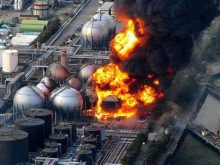The World is at a critical crossroads. The Fukushima disaster in Japan has brought to the forefront the dangers of Worldwide nuclear radiation. The crisis in Japan has been described as “a nuclear war without a war”. In the words of renowned novelist Haruki Murakami: “This time no one dropped a bomb on us … We set the stage, we committed the crime with our own hands, we are destroying our own lands, and we are destroying our own lives.” Nuclear radiation –which threatens life on planet earth– is not front page news in comparison to the most insignificant issues of public concern, including the local level crime scene or the tabloid gossip reports on Hollywood celebrities. While the long-term repercussions of the Fukushima Daiichi nuclear disaster are yet to be fully assessed, they are far more serious than those pertaining to the 1986 Chernobyl disaster in the Ukraine, which resulted in almost one million deaths (New Book Concludes – Chernobyl death toll: 985,000, mostly from cancer Global Research, September 10, 2010, See also Matthew Penney and Mark Selden The Severity of the Fukushima Daiichi Nuclear Disaster: Comparing Chernobyl and Fukushima, Global Research, May 25, 2011) Moreover, while all eyes were riveted on the Fukushima Daiichi plant, news coverage both in Japan and internationally failed to fully acknowledge the impacts of a second catastrophe at TEPCO’s (Tokyo Electric Power Co Inc) Fukushima Daini nuclear power plant.
Tag: Fukushima
60% of Japan’s 48 viable nuclear reactors, are not as yet being considered for application to the Nuclear Regulation Agency (NRA) for restart 90% of Japan reactors to be out of service Japan’s…
An employee (C) of Tokyo Electric Power Co. (TEPCO) measures using a dosimeter at the central operating control room of the No. 1 and No. 2 reactors at TEPCO’s tsunami-crippled Fukushima Daiichi nuclear power…
Video Professor Noam Chomsky traveled to Japan last week ahead of the three-year anniversary of the Fukushima crisis. Posted March 11, 2014 For a video presentation, please click here: http://www.informationclearinghouse.info/article37902.htm Democracy NOW!
Does anyone in authority anywhere tell the truth about Fukushima? If there is any government or non-government authority in the world that is addressing the disaster at Fukushima openly, directly, honestly, and effectively, it’s not apparent to the outside observer what entity that might be. There is instead an apparent global conspiracy of authorities of all sorts to deny to the public reliably accurate, comprehensible, independently verifiable (where possible), and comprehensive information about not only the condition of the Fukushima power plant itself and its surrounding communities, but about the unceasing, uncontrolled release of radioactive debris into the air and water, creating a constantly increasing risk of growing harm to the global community. While the risk may still be miniscule in most places, the range of risk rises to lethal in Fukushima itself. With the radioactive waste of four nuclear reactors (three of them in meltdown) under uncertain control for almost three years now, the risk of lethal exposure is very real for plant workers, and may decrease with distance from the plant, but may be calculable for anyone on the planet. No one seems to know. No one seems to have done the calculation. No one with access to the necessary information (assuming it exists) seems to want to do the calculation.
New Radiation Hotspot at Crippled Fukushima Nuclear Power Plant discovered. Radiation in Well near Storage Tank spikes 6.500 Times above the Level of the previous Day. The radiation level in a well near…
Japanese Sovereignty Should Not be Violated Petitioning the American government and the United Nations to take over the Fukushima clean-up would be morally wrong and a political folly. The argument goes that since…
The world community must now take charge at Fukushima! We are now within two months of what may be humankind’s most dangerous moment since the Cuban Missile Crisis. There is no excuse for…
An unstoppable tide of radioactive trash and chemical waste from Fukushima is pushing ever closer to North America. An estimated 20 million tons of smashed timber, capsized boats and industrial wreckage is more than halfway across the ocean, based on sightings off Midway by a Russian ship’s crew. Safe disposal of the solid waste will be monumental task, but the greater threat lies in the invisible chemical stew mixed with sea water. This new triple disaster floating from northeast Japan is an unprecedented nuclear, biological and chemical (NBC) contamination event. Radioactive isotopes cesium and strontium are by now in the marine food chain, moving up the bio-ladder from plankton to invertebrates like squid and then into fish like salmon and halibut.
IAEA urges Japan’s atomic regulator to explain to public more clearly about latest leak of radioactive water at tsunami-damaged energy plant Experts inspect contaminated water tanks at the Fukushima Dai-ichi nuclear power plant in…

